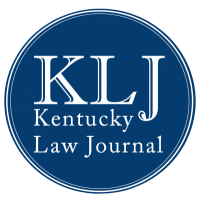Blog Post | 110 KY. L. J. ONLINE | November 8, 2021
The Conundrum of Racial Epithet Frequency in Employment Discrimination Cases
By: Taylor Ecleberry, Staff Editor, Vol. 110
To prove a hostile work environment claim under Title VII, an employee must show they were subjected to harassment that is “sufficiently severe or pervasive to alter the conditions of the victim’s employment and create an abusive working environment.”[1] Although this definition does little to articulate a workable standard, the Supreme Court in Harris v. Forklift Systems, Inc. held a single use of a racial epithet is not enough for a hostile work environment claim.[2] But, subsequently noted an isolated, serious incident could be enough to constitute a hostile work environment claim if the incident is severe enough.[3] Seemingly, the Supreme Court holdings present an interesting dichotomy: whether a single use of an egregious racial epithet can constitute a “mere utterance” that fails to qualify as a hostile work environment claim or a “serious incident” that amounts to a hostile work environment claim.[4]
Not surprisingly, the lack of direction from the Supreme Court has caused Circuit Courts to split.[5] According to Forbes:
“[i]n two of the thirteen federal courts of appeal, a single use of the N-word at work can establish a hostile work environment claim. But in at least five other federal courts of appeal. . .the courts routinely find that a hostile work environment cannot be proven by a single use of the N-word.”[6]
In January 2021, the Supreme Court was asked to clarify the doctrine in Collier v. Dallas County Hospital District, which dealt with whether an isolated usage of an egregious racial epithet would be enough to constitute a hostile work environment claim. In May 2021, the Supreme Court denied review of Collier,[7] much to the chagrin of employment law specialists who were hopeful Collier would finally lay to rest the Circuit split.[8]
With little direction from the Supreme Court, combined with the projected uptick in employment discrimination cases,[9] the lack of a cohesive standard continues to severely disadvantage employees who will likely get different treatment depending on their geographic location. The most poignant illustration of such disparity is found by looking at the difference in how the Tenth Circuit and Fourth Circuit handled a case in which there were two instances of egregious racial epithets being used against an employee. The Tenth Circuit ruled two overtly racial remarks during eight years of employment was not frequent enough to constitute a hostile work environment claim.[10] Whereas, in Boyer-Liberto v. Fontainebleau Corp., the Fourth Circuit held “an employee is protected. . .for opposing an isolated incident of harassment when the employee reasonably believes that a hostile work environment is in progress.”[11]
In conclusion, when dealing with racial epithets in employment discrimination cases, it hardly makes sense for the sufficient frequency determination to hinge on the geographic location the victim happens to bring a claim. Instead, there should be a uniform delineation between what constitutes a “mere utterance” and what constitutes a “serious incident,” which seems like a task only the Supreme Court can resolve.
[1] Harris v. Forklift Systems, Inc., 510 U.S. 17, 21 (1993) (quoting Meritor Sav. Bank, FSB v. Vinson, 477 U.S. 57, 67 (1986)).
[2] Id.
[3] Faragher v. City of Boca Raton, 524 U.S. 774, 788 (1998).
[4] Eric Bachman, Can A Single Racial Epithet—No Matter How Odious—Create A Hostile Work Environment?, Forbes (May 4, 2021, 1:32 P.M.), https://www.forbes.com/sites/ericbachman/2021/05/04/can-a-single-racial-epithet-no-matter-how-odious-create-a-hostile-work-environment/?sh=15b1c29b4c4c.
[5] Id.
[6] Id.
[7] Collier v. Dallas County Hospital District, SCOTUSblog, https://www.scotusblog.com/case-files/cases/collier-v-dallas-county-hospital-district/.
[8] Bachman, supra note 4.
[9] Katie Clarey, Attorneys predict busy year for EEOC enforcement, HRDive (Oct. 5, 2021), https://www.hrdive.com/news/attorneys-predict-busy-year-for-eeoc-enforcement/607658/.
[10] Bolden v. PRC Inc., 43 F.3d 545, 551 (10th Cir. 1994).
[11] Boyer-Liberto v. Fontainebleau Corp., 786 F.3d 264, 284 (4th Cir. 2015).

